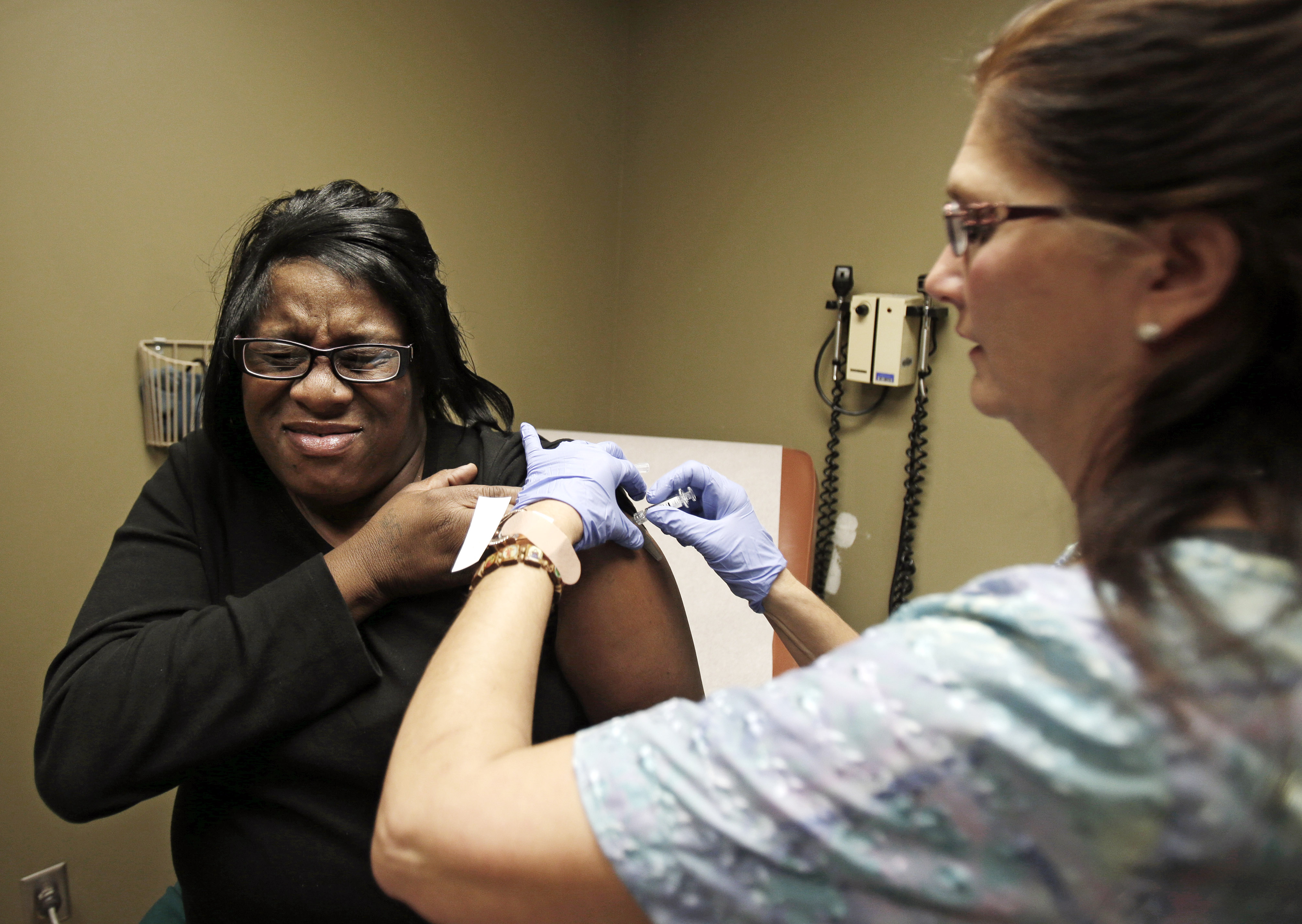 FILE - In this Jan. 10, 2013, nurse Debbie Smerk, left, administers a flu shot to Pamela Black at MetroHealth, in Cleveland. A new report shows this winter’s nasty flu season has peaked and is clearly retreating. The flu reached its highest levels around the beginning of January, and stayed there for weeks. The government report out Friday, Feb. 13, 2015, shows flu has become less widespread and less intense in the last couple of weeks. (AP Photo/Tony Dejak, File)
FILE - In this Jan. 10, 2013, nurse Debbie Smerk, left, administers a flu shot to Pamela Black at MetroHealth, in Cleveland. A new report shows this winter’s nasty flu season has peaked and is clearly retreating. The flu reached its highest levels around the beginning of January, and stayed there for weeks. The government report out Friday, Feb. 13, 2015, shows flu has become less widespread and less intense in the last couple of weeks. (AP Photo/Tony Dejak, File) PEDIATRIC DEATHS IN TENNESSEE
These figures are for the calendar year, but health officials also look at deaths per season, which spans the end of one calendar year and the beginning of another. For example, there were 10 flu-related deaths in 2014, but six were from this current flu season, along with the three reported in 2015. 2007 -- 2 deaths 2008 -- 2 deaths 2009 -- 15 deaths 2010 -- 1 death 2011 -- 0 deaths 2012 -- 1 death 2013 -- 3 deaths 2014 -- 10 deaths (six from the 2014-2015 flu season) 2015 -- 3 deaths to date Source: Tennessee Department of Health
TOP 10 CITIES WITH FLU ACTIVITY
1. Oklahoma City, Okla. 2. Harlingen-Weslaco-Brownsville-McAllen, Texas 3. Dallas-Fort Worth, Texas 4. Jackson, Miss. 5. Fort Smith-Fayetteville, Ark. 6. Knoxville, Tenn. 7. Austin, Texas 8. Little Rock-Pine Bluff, Ark. 9. Chattanooga, Tenn. 10. Tulsa, Okla. Source: Walgreens Flu Index
At least two Hamilton County children have died from flu-related complications this season, joining the toll of the largest number of flu-related pediatric deaths Tennessee has seen since the H1N1 pandemic in 2009, state officials said.
So far, nine Tennessee children have died from the flu this season, health officials have confirmed.
"The flu hit Tennessee hard this year, and we're not completely out of the woods yet," said Dr. Kelly Moore, director of the Tennessee Department of Health immunization program. "We are still reporting influenza activity."
Most hospitalizations this season were from Type A flu, which includes the H3N2 strain. But that strain has largely tapered off and been replaced by a wave of the Type B flu strain, which is typically less severe, doctors say. While the vaccine may not have prevented H3N2, it should do a better job helping to ward off the Type B strain, physicians say.
Meanwhile, Chattanooga took the No. 9 slot in the nation for flu activity this season, according to prescription data released by the pharmacy chain Walgreens on Monday.
That data is based on the rates of prescriptions filled for antiviral flu drugs like Tamiflu and Relenza from last November through February, broken down by ZIP code.
The number of adult deaths from the flu is not tracked by health officials, since often those deaths are technically caused by conditions like pneumonia or stroke.
It is unknown how many of the children who died this year were vaccinated. But this year's vaccine was considered much less effective by health officials, since the season's dominant flu strain, H3N2, was not included.
"The benefits of the vaccine were very disappointing," Moore said. "That happens rarely. It was unavoidable, because the year's big strain didn't show up until the strains for the vaccine were already selected."
That has resulted in "really, really high hospitalization rates" for adults age 65 and older, she said. While those rates are not tracked locally, the U.S. Centers for Disease Control and Prevention reported in its last survey that there had been 278 flu-related hospitalizations in that age range per 100,000 population. The next highest rate -- among children ages 0 to 4 -- was 49.5.
Overall, flu numbers are beginning to decline locally as spring arrives.
"We're still seeing some flu, but the numbers are way down since January," said Bev Fulbright, epidemiology manager at the Chattanooga-Hamilton County Health Department. "Just looking at some of the data, in January we were seeing more Type A. In March, we are seeing more Type B. But the overall numbers are much, much lower."
Health department surveillance of local doctors' offices shows that the 2014-2015 flu season was significantly worse than last year's, but that the number of cases has dropped more dramatically after the New Year.
Dr. Tye Young, an internal medicine physician with UT Erlanger East Primary Care, said the peak of this season's flu activity came early.
"The bulk of the cases came before the first of the year," he said, adding that he saw people of all ages in his office. "But since then, things have since slowed down considerably."
According to Erlanger's hospital flu report, the flu's peak was during Christmas week, when 212 people were treated for the virus. Last week, just 13 people were treated. Cumulatively, the hospital has treated 1,253 cases this season.
Young said he had two patients who tested positive for the flu this week, but he is hopeful they will be his last.
"I don't think we'll see this season go into April," he said. "I think we're almost done."
Contact staff writer Kate Belz at kbelz@timesfreepress.com or 423-757-6673.
